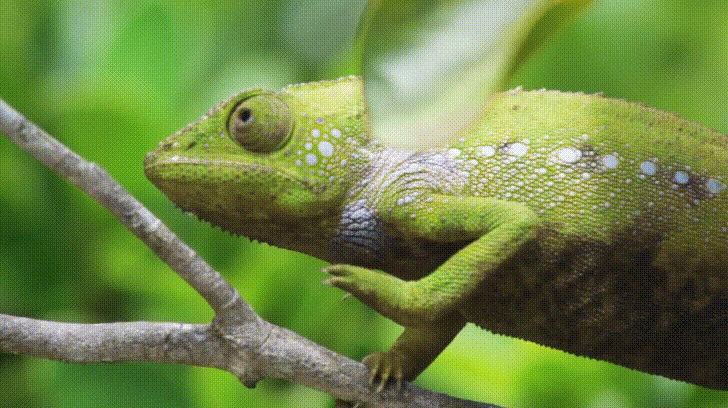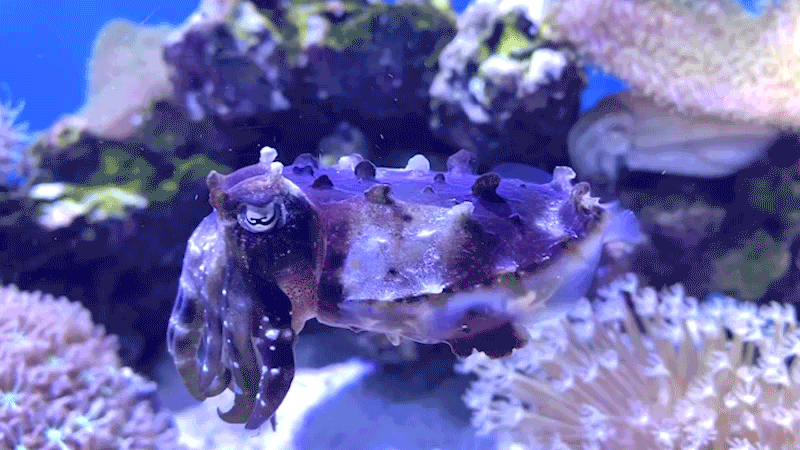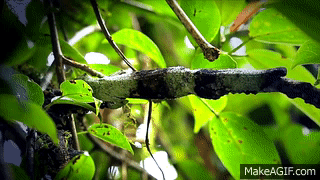Nature creates incredible masterpieces in the animal kingdom, where creatures have mastered the art of disappearing in plain sight. Let's see the top 10 extraordinary camouflage techniques that help these animals hide and thrive.
Chameleons: Colorful Transformations

Chameleons, the wizards of color, effortlessly change shades to match their surroundings and communicate with fellow chameleons. Their ability to transform isn't just for show; it's a survival strategy, allowing them to blend seamlessly into the vibrant landscapes they call home. From earthy browns to lush greens, chameleons showcase a kaleidoscope of hues, adapting to the ever-changing canvas of their environment.
Cuttlefish: Ocean's Shape-Shifters

Meet the cuttlefish, the ocean's shape-shifters, using their soft bodies and skin cells to mimic the textures and colors of the seafloor. Their remarkable ability to morph into different shapes and patterns serves as a dynamic camouflage tactic, allowing them to navigate the underwater world undetected by both prey and predators. Cuttlefish are true masters of disguise, turning the ocean depths into their ever-changing canvas.
Stick Insects: Nature's Living Twigs

Stick insects, mimicking twigs or branches, become invisible among the vegetation they call home. Their slender bodies and twig-like appearance provide the perfect disguise, allowing them to evade the keen eyes of predators. These masters of mimicry not only resemble twigs but also adopt the subtle swaying movements of branches, creating a convincing illusion that leaves observers questioning what is truly alive in the forest.
Katydids: Leaf-Like Illusions in the Night

Katydids, masters of nighttime camouflage, mimic leaves to perfection, blending seamlessly into the dark foliage. Their remarkable resemblance to leaves not only serves as a protective measure but also enables them to become active during the night without drawing attention. With their leaf-like wings and a knack for blending into the shadows, katydids exemplify nature's ingenious adaptations for survival in the cover of darkness.
Owl Butterfly: Winged Eyespots

Discover the owl butterfly, equipped with large eyespots on its wings, creating the illusion of an owl's face to deter predators. This clever adaptation not only startles potential threats but also serves as a visual deception, making the butterfly appear larger and more formidable. The owl butterfly's mimicry showcases the power of visual tricks in the natural world, where survival hinges on creating illusions that deceive the eyes of would-be adversaries.
Uroplatus Geckos: Tree Bark Impersonators

Uroplatus geckos from Madagascar skillfully mimic tree bark, avoiding detection by predators in the rainforests. These geckos, with their flattened bodies and bark-like patterns, seamlessly merge with the tree trunks they inhabit. Their ability to imitate the texture and color of tree bark allows them to remain hidden during the day, becoming elusive masters of camouflage in the dense foliage of Madagascar's unique ecosystems.
Seahorses: Coastal Camouflage Wizards

Seahorses, coastal camouflage wizards, blend into seagrasses and corals, becoming nearly invisible to passing predators. Their slender bodies and ability to change color enable them to mimic the surrounding environment, providing effective camouflage against the backdrop of underwater flora. Seahorses exemplify the art of blending in, showcasing how these delicate creatures navigate the coastal shallows by seamlessly merging with their surroundings.
Mantis Shrimp: Colorful Underwater Disguises

Mantis shrimp, with their vibrant colors, blend into coral reefs, showcasing a stunning display of underwater camouflage. Despite their bright hues, mantis shrimp leverage their surroundings, using the intricate patterns and textures of coral to conceal themselves from potential threats. Their ability to harmonize with the vibrant underwater landscapes illustrates how color adaptation plays a crucial role in their survival strategy within the complex ecosystems of coral reefs.
Arctic Fox: Winter Coat Mastery

Arctic foxes change their fur color to seamlessly adapt to the snowy landscape of the Arctic tundra. In winter, their fur transforms to a pristine white, allowing them to vanish into the snowy expanses and hunt with stealth. This seasonal adaptation is not just an aesthetic change but a practical response to the harsh Arctic environment. Arctic foxes showcase the significance of color adaptation in ensuring survival amidst the unforgiving conditions of the frozen north.
Leaf-Tailed Geckos: Forest Floor Illusionists

Leaf-tailed geckos from Madagascar perfectly resemble dead leaves on the forest floor, avoiding detection by predators. Their bodies, adorned with leaf-like patterns and irregular edges, closely mimic the fallen foliage. By blending seamlessly with the forest floor, these geckos evade the watchful eyes of predators, showcasing an incredible example of adaptive camouflage in the intricate ecosystems of Madagascar's rainforests. Leaf-tailed geckos illustrate how mastering the art of illusion can be a lifesaving strategy in the intricate dance between prey and predator.
Before we wind up, take a moment to ponder the incredible strategies these creatures employ for survival. What if you could change colors like a chameleon or seamlessly blend into your surroundings like a stick insect? How would you navigate life's challenges with the artful mastery of these invisible wonders? Nature's grand illusionists invite us to marvel at their adaptations and perhaps consider, if given the chance, which creature's camouflage strategy would you adopt for your own remarkable journey? Share your thoughts and let the conversation unfold!


You must be logged in to post a comment.